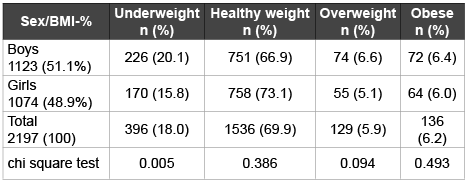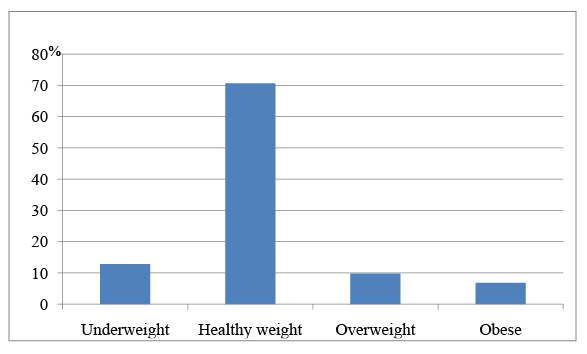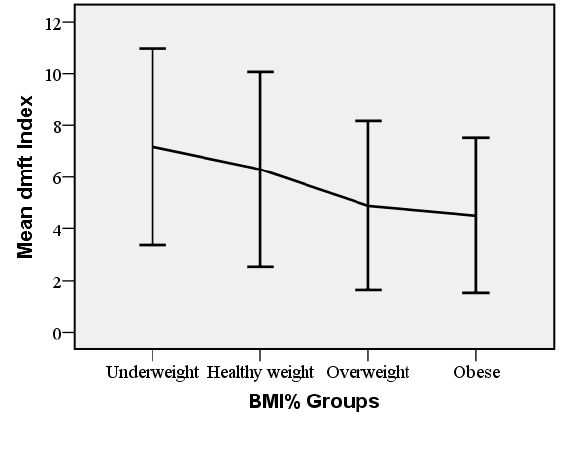
Table 1: Distribution of BMI-% groups according to sex among 6-year old children.

Mostafa Sadeghi1 Michael W. Roberts*2
1Department of Operative Dentistry, School of Dentistry, Rafsanjan University of Medical Sciences, Rafsanjan, Iran*Corresponding author: Michael W. Roberts, DDS, MScD, UNC School of Dentistry, Department of Pediatric Dentistry, 228 Brauer Hall, CB # 7450, Chapel Hill, NC 27599-7450, USA, Tel: (919)537-3781; Fax: (919)537-3950; E-mail: Mike_Roberts@unc.edu
Objectives: The purpose of this cross-sectional study was to determine whether there is a relationship between dmft (decayed, missing and filled primary teeth) index and Body Mass Index for age (BMI-%) in 6-year-old children.
Study design: A census sample of 2197 healthy children(51.1% boys/48.9% girls) aged 72-84 months with a mean age of 77.52 ± 3.49 months was included. The dmft index and BMI-%were obtained for each child.The data was analyzed by chi-square, Mann-Whitney, KruskalWallis, Spearman’s rho coefficient tests (p ≤ 0.05).
Results: The mean and SD of BMI-% was 15.21 ± 2.08 with a distribution of underweight (18.0%), healthy weight (69.9%), overweight (5.9%) and obese were (6.2%) per Centers for Disease Control and Prevention guidelines. The mean and SD of dmft index was 6.27 ± 3.76; this variable according to BMI-%categories were 7.18 ± 3.81 (underweight), 6.30 ± 3.77 (healthy), 4.89 ± 3.28 (overweight) and 4.51 ± 3.01 (obese). There was a significant inverse relationship between BMI-% scores and dmft index and decayed teeth. There was also a positive relationship between BMI% scores and students that were caries free.
Conclusions: An inverse relationship between BMI-% and dmft index, and a positive relationship between BMI-% and being caries free was observed.
dmft index; BMI-for-age; BMI percentile; Dental caries; Preschool children
Obesity is a principle factor that increases the risk of some chronic and life threatening disorders [1,2]. Obesity in childhood is an increasing epidemic and represents one of the most serious public health concerns of the 21st century impacting on the physical and psychological health of children [3-12].
In 2013, it was estimated that 42 million children worldwide under the age of five years were overweight. Close to 31 million of these are living in developing countries [6]. Iran has experienced a rapid change in life style characterized by a decrease in physical activity and an increase in calorie intake leading to a rapid increase in overweight individuals since the 1990s [13,14].
Body Mass Index (BMI) is a universally accepted method and practical indicator to assess the body weight in adults [2]. In children and teenagers, with the age range of 2-20 years, BMI is combined with age and gender and expressed as a percentile (BMI-%). The age and gender specific BMI- %values are referred to as “BMI-for-age”. According to the Centers for Disease Control and Prevention (CDC), BMI-%are categorized as: 1) underweight (less than 5th percentile), 2) healthy weight 5th percentile to less than 85th percentile), 3) overweight (85th percentile to less than 95th percentile and [4]) obese (95th percentile or greater) [6,9,12].
Dental caries is a multi-factorial and chronic disease [13]. Although its prevalence has been declining in many countries, it is still an important public health issue as developing countries are facing a transition in epidemiological diseases, and nutritional patterns [14]. A study showed that mean dmft index and caries free prevalence among 6-year-old students were 3.4 ± 2.7 and 16% in three Iranian communities [15].
Although a relationship between dental caries and excess weight is biologically plausible, the documentation of such a relationship, especially in 6-year-old children, is limited and controversial. A recent study in children 6 years of age reported that 9% of the children were underweight and 6% were obese and there was a significant association (P = 0.04) between BMI-for-age and dental caries [16].
Underweight children often have a disruption of intake and absorption of vital nutrients, and are at risk for infections due to a weak and easily compromised immune system [17,18]. Some studies found that underweight children had higher dmft/DMFT scores than overweightobese children [19-21]. In contrast, other studies have indicated that obese children are more likely to have dental caries than underweight or health weight [22,23].
Children at the preschool-age (five years) are the index age group for the WHO in assessing dental caries in primary teeth [24]. However, in Iran, the optimum age for school entry is at six years of age; hence this age was used for our study. The aim of the present study was to determine the relationship between BMI-% and dmft index in an unselected sample of 6-years old children in Rafsanjan, Iran. The null hypothesis was that there is no relationship between BMI-% and prevalence of dental caries in the examined children.
This cross-sectional study was conducted on 2197 children ranging in age from 72 to 84 months with a variety of social backgrounds using a census sampling method. A required pre-school physical examination gathered individual and family demographics, vaccination status, weight and height measurements (BMI-%), growth monitoring, audiometry, optometry, oral and dental evaluation and fluoride exposure. The children suspected to have any illness were excluded from the present study.
All the healthy subjects identified in the screening program that were in the primary dentition were enrolled in this study. Approval was obtained from the ethical committee of Rafsanjan University of Medical Sciences (14 April 2015) and informed written consent was obtained from the parents of the participants. The age of the subjects was obtained from their date of birth records.
Diagnosis of dental caries was established according to the WHO methodology and criteria [24] and performed by two trained/calibrated final year dental students (kappa=0.92) using a non-invasive technique that was supervised by a specialist in operative dentistry. The children were seated in a chair and examined visually with optimal illumination, community periodontal index (CPI) probe, disposable dental mirror (Atlas Teb Co, Tehran, Iran) and tongue blade. Cotton rolls were used to remove any plaque or debris. Dental radiographs were not obtained.
The deft index was recorded for the primary dentition. Caries was recorded as being present when there was a lesion in a pit or fissure, or on a smooth tooth surface, had a detectably softened floor, undermined enamel, or softened wall. Restored teeth with recurrent caries and teeth filled with temporary materials were included in this category. White spots were not considered as being decayed. A tooth was recorded as missing if it had been extracted for caries. Teeth extracted or missing due to trauma or absent because of natural tooth exfoliation were not included into consideration in assessing the missing component. Teeth were recorded as filled when one or more permanent restorations were present and there was no remaining caries.
Children’s weight and height were measured according to standard protocols. The bodyweight of each child was recorded to the nearest 0.1 kg using a standard digital scale (Seca Co, Hanover, Maryland, USA) with the subject barefoot and wearing light clothing. The scale’s balance was calibrated at the beginning of each working day and at frequent intervals throughout the day. Body height was measured to the nearest 0.5 cm using a stadiometer (Seca Co) with subjects wearing no shoes, heels together and head touching the ruler with line of sight aligned horizontally. Body mass index percentile was determined according to Centers for Disease Control and Prevention (CDC) guidelines and assorted into underweight, healthy weight, overweight or obese [12].
Statistical evaluation of data was analyzed with SPSS-20 (SPSS Inc., Chicago, IL, USA) software. Normal distribution of all variables was not confirmed using the Kolmogorov-Smirnov test (p=0.001); therefore, the Kruskal-Wallis H test was used to detect the differences between the median of d, m and f components; dmft index and percentage of caries free with BMI-% scores; the Mann-Whitney U test was used to assess the median age, d, m and f compartments; dmft index and percentage of caries free by sex. The chi-square test was used to determine the difference between BMI-% groups by sex and Spearman’s rho correlation coefficient was used to evaluate the relationships between independent variable (BMI-%) and dependent variables (dmft index and percentage of caries free subjects). P value < 0.05 was considered statistically significant.
In this study, there was no significant difference in the number of boys and girls (p=0.296). The boys were significantly older (p=0.017) and heavier (p=0.016). The BMI-% distribution can be seen in table 1. The chi-square test showed that the frequency of underweight subjects was significantly higher among boys as compared to girls (P=0.005).
Table 2 shows the mean and standard deviation (SD) of dmft index and its components and percentage of caries free according to sex. The mean and SD of dmft index and its components and percentage of caries free according to BMI-% groups are presented in table 3. The Kruskal-Wallis H test demonstrated that these variables had significant differences within all BMI-%. Figure 1 demonstrates the percentage of caries free children in BMI-% groups. A statistically significant inverse relationship between BMI-% scores and dmft index was noted (p=0.001). There was also a significant positive relationship between BMI-% scores and percentage of caries free (rs=0.063; p=0.003). A significant inverse relationship between BMI-% scores and dmft index and decayed teeth was observed in this study (p=0.001) (Figure 2).
The present study evaluated the relationship between BMI-% and dmft index in 6-old-year students entering the first grade. Sampling bias was minimized and the results are more reliable because children in a single age (6-year-old) were selected by a census sampling method.
Childhood dental caries and childhood underweight/obesity are multifactorial with predisposing genetic and environmental components. Dental caries is an infectious disease and underweight/obesity results from an imbalance between diet calorie intake and the body energy requirements and have significant adverse implications for health [25]. The relationship between weight and dental caries in children is complex and has been investigated with contradicting results [26,27]. Our findings are in agreement with some previous studies that were done on primary (deciduous) teeth [19,28-32]. A literature review did not reveal sufficient evidence regarding the association between obesity and dental caries [33]. However, some previous studies supported a significant relationship between childhood obesity and dental caries. However, some researchers have reported a direct significant relationship between BMI and dmft index [34-38].
Underweight children may be more susceptible to infectious diseases such as dental caries due to a compromised immune system. Dental caries can cause tooth pain and difficulty during mastication [39], thus these children often favor soft foods. This may help explain why children with low body weight may be at a higher risk of developing dental caries [19,40]. Dental treatment of underweight children can improve the growth indicators [41]. Theoretically, there is a putative relationship between excess weight and dental caries. However, many risk factors including diet, genetics, psychological and behavioral factors, and parental weight and dental status, and oral hygiene practices contribute to childhood obesity and dental caries [2,34,39,42]. Further studies are needed to investigate the unique role of these factors. In our study, the prevalence of healthy weight children was highest (69.9%), followed by underweight (18%) and then overweight/obese (12.1%). This is in line with a national survey and cross sectional study [22,25].

Table 1: Distribution of BMI-% groups according to sex among 6-year old children.

Table 2: Mean ±SD of d, m and f components, dmft index; and percentage of caries free children among 6-year-old children according to sex. † chi square test

Table 3: Mean ± SD of d, m and f components; and dmft index and percentage of caries free children according to BMI-% among 6-year old children. † chi square test

Figure 1: Percentage of caries free individuals according to BMI-% categories among 6-year old children.

Figure 2: Distribution of dmft index according to BMI-% among 6-year old children.
The mean dmft score of the study population was 6.27 ± 3.76. The biggest portion of the dmft index was decayed (88.6%), while the least was missing teeth (4.9%). These components were only significantly higher in boys (p=0.019). Another nationwide survey on 8725 6-year-olds in Iran showed that the mean dmft index was 5.0 (d, m and f were 4.4, 0.4 and 0.2, respectively and girls had a significantly lower (4.6) mean dmft than boys (5.3) [43]. An explanation for these differences between boys and girls remains speculative.
The data showed that dmft index in healthy weight children were significantly higher compared with overweight and obese children, and lower than underweight individuals (p<0.05). Dental caries prevalence in healthy weight were 1.39 times and 1.47 times significantly greater than overweight and obese children, respectively; and 1.2 times lower than underweight individuals (p<0.05). It seems that children with severe caries may have eating or food access issues and could possibly lose weight due to caries and associated pain [39]. Bafti et al. [29] showed that the caries rate in the primary teeth of 3-6-year-old children decreases with an increase in body weight, and the mean of dmft for normal BMI children was 1.5 fold greater for children who were overweight.
In the present study 6.1% of children were caries free. Among the caries free children, 12.8% were underweight, 70.7% were a healthy weight, 9.8% were overweight and 6.8% were obese. There was a significant positive relationship between BMI-% and caries free (p=0.003). Healthy weight children may have had access to a healthier diet than underweight or obese children. It is a challenge to explain why as a group the healthy weight children had a high dmft score but the group also had the highest number of caries free children. This would suggest that factors beyond diet are important when considering a particular child’s risk for caries as the high incidence of dmft is among a select few.
A limitation of this cross sectional study is that no cause-effect relationship can be determined between dental status and BMI-%; therefore, further longitudinal designs are needed to clarify possible factors affecting this relationship.
This study was supported by a grant from the Research Vice Chancellor of Rafsanjan University of Medical Sciences. The authors express their gratitude to A. Nouri and Z. Jamali for assisting in the dental examinations.
Download Provisional PDF Here
Aritcle Type: Research Article
Citation: Sadeghi M, Roberts MW (2016) The Relationship between BMI-for-age (BMI-%) and dmft Index of 6-year-Old Children in Rafsanjan, Iran. Int J Dent Oral Health 2(2): doi http://dx.doi. org/10.16966/2378-7090.175
Copyright: © 2016 Sadeghi, et al. This is an open-access article distributed under the terms of the Creative Commons Attribution License, which permits unrestricted use, distribution, and reproduction in any medium, provided the original author and source are credited.
Publication history:
All Sci Forschen Journals are Open Access